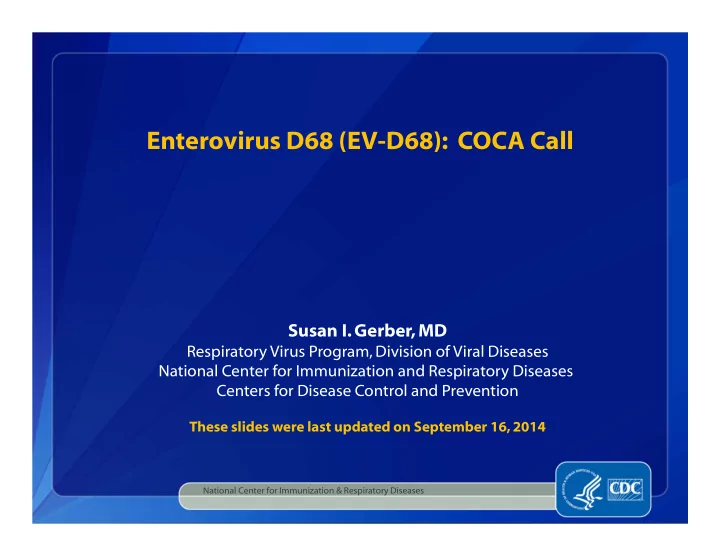

Enterovirus D68 (EV-D68): COCA Call Susan I. Gerber, MD Respiratory Virus Program, Division of Viral Diseases National Center for Immunization and Respiratory Diseases Centers for Disease Control and Prevention These slides were last updated on September 16, 2014 National Center for Immunization & Respiratory Diseases
Enteroviruses (EVs) Very common viruses, > 100 types ~10-15 million infections in US each year Cause respiratory illness, febrile rash illness (HFMD), neurologic illness Most infected people are asymptomatic or have mild symptoms Infants and children more likely to become ill Seasonality summer and fall
Enteroviruses (EVs) EVs are not nationally notifiable Nationally, there are 2 voluntary, passive laboratory surveillance systems that include information about EVs: NREVSS- National Respiratory and Enteric Virus Surveillance System NESS- National Enterovirus Surveillance System
NREVSS Passive Collects data on a number of viruses, but not type Total number of tests performed and those that are positive (not patient level) Proportion of positive tests are tracked Seasonality for EVs has been consistent yearly: summer and fall
NESS Voluntary and passive Collects data on types of enteroviruses and parechoviruses Detections with: Age, gender, state, specimen collection date, specimen type, virus type
NESS Data During 2009-2012: 15 labs (including CDC) reported to NESS Detections reported in 43 states and Puerto Rico Specimen types: • CSF, OP/NP swabs– stool/rectal swabs Mostly young children
NESS Data II Type was reported for 1257 (68%)of 1859 detected EV and HPeV Considerable variation between years regarding EV and HPeV types EV-D68 has been detected along with parecho type 3, CA6, echoviruses…. Gives us a glimpse of what is circulating but influenced by attention received and investigations performed
EV-D68 Thought to occur less commonly First identified in 1962 Known to cause respiratory illness Known to infect children and adults Similar to rhinoviruses Clusters have previously been described in the US, Europe, and Asia
EV-D68 Clusters Since 2008 several small clusters of EV-D68 described: Largest in Japan, 120 cases reported Most clusters reported < 30 cases Most clusters without fatalities • 2 of 21 cases from Philippines cluster died • 1 of 11 known cases from Japan died
2014: First Signals Detected Increase in severe respiratory illnesses among children, PICU, hospitalizations as compared to same time frame previous years Increase in rhinovirus/enterovirus detections from multiplex PCR assays, as compared to same time frame previous years
EV-D68 Outbreak in the US MMWR- Missouri and Illinois: 19 Kansas City (KC) in PICU; 10 of 11 in Chicago PICU Children (range 6wks-16yrs- median 4 and 5yrs) Most patients with history of asthma or reactive airway disease ( 68% KC and 73% Chicago) Minority of patients with fever (26% febrile in KC and 18% in Chicago) Oxygen requirement to mechanical ventilation
Current Status as of 9-16-14 130 patient specimens where EV-D68 has been identified Of those, 117of 219 (53%) specimens have been confirmed at the CDC lab • 13 specimens confirmed at NY State Public Health Laboratory 12 states affected What is different is the magnitude or degree of identification of EV-D68
States Where EV-D68 Confirmed: 9-16-14 Missouri Louisiana Colorado New York Illinois Indiana Iowa Oklahoma Kansas Pennsylvainia Kentucky Alabama
EV-D68 State of Residence
Other Respiratory Viruses Circulating Not all detections have been EV-D68 Rhinoviruses Coxsackieviruses Echoviruses
Lab Testing Few states have the ability to identify EV-D68 To determine EV-D68 requires sequencing of the VP1 region of the genome Need for a real time PCR assay……..
Infection control Standard and contact precautions as is recommended for all enteroviruses As EV-D68 is a cause of clusters of respiratory illness, similar to rhinoviruses, droplet precautions also should be considered as an interim recommendation until there is more definitive information available on appropriate infection control.
Environmental Disinfection Environmental disinfection Bleach works Hospital grade disinfectant with an EPA label claim for any of the several non-enveloped viruses
Reporting Not nationally notifiable Reporting of clusters Some states may have specific reporting requirements Clinicians should report to local and state health departments if suspected clusters of EV-D68
Priorities for Testing Severely ill patients New populations Adults Group settings New locations
Conclusions EV-D68 not new EV-D68 is being identified in more specimens than expected Increased respiratory illnesses not all EV-D68, though EV-D68 appears to be a predominant identification in some locations Spectrum of illness needs more investigation
For more information please contact Centers for Disease Control and Prevention 1600 Clifton Road NE, Atlanta, GA 30333 Telephone, 1-800-CDC-INFO (232-4636)/TTY: 1-888-232-6348 E-mail: cdcinfo@cdc.gov Web: www.cdc.gov The findings and conclusions in this report are those of the authors and do not necessarily represent the official position of the Centers for Disease Control and Prevention. National Center for Immunization & Respiratory Diseases
Recommend
More recommend